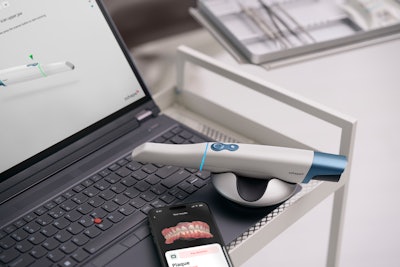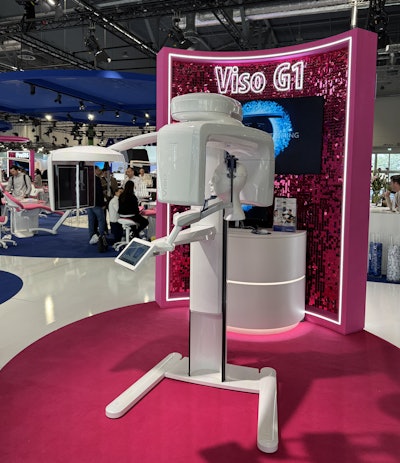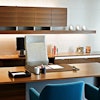COLOGNE, Germany - The International Dental Show (IDS) officially opened to the world on Tuesday, March 24, with new products as the focus and the future of dentistry worldwide as a unifying talking point among exhibiting companies and attendees.
New product: Trios 6 intraoral scanner from 3Shape
It may have been early in the morning and a breakfast press conference, but 3Shape executives were certainly excited about the launch of the Trios 6, the latest iteration of their cutting-edge intraoral scanning technology.
Along with the new scanner that reportedly adds up to 110% high-scan resolution from previous versions of Trios, cutting-edge assistive diagnostic software is also available that provides objective, consistent results for detecting caries, tooth wear, gingival recession, and plaque.
 The Trios 6 intraoral scanner and the DentalHealth app from 3Shape. Image courtesy of 3Shape.
The Trios 6 intraoral scanner and the DentalHealth app from 3Shape. Image courtesy of 3Shape.
Personally, one of the things I was most impressed with during the presentation was the launch of the DentalHealth app that allows patients to not only see the scans of their teeth, but it also highlights problem areas and areas for improvement. To me, it was the perfect complementary piece to case presentation, as it goes home with the patient and allows patients to see what the dental team is seeing on their phone in the comfort of their home.
Learn more about the Trios family.
New product: Cytrans Granules from GC
Recently launched in the U.S., Cytrans Granules was a focal point for GC America during a press conference Tuesday. Cytrans is a carbonate apatite, resorbable bone graft material that is animal-free.
According to GC, the product allows excellent osteoconductivity, early bone formation, and gradual replacement with the host bone. Learn more about Cytrans Granules, and check out our exclusive interview with Joseph Talanges, president and chief operating officer of GC America.
New product: Planmeca Viso G1
 The Viso G1 CBCT scanner. Image courtesy of Planmeca.
The Viso G1 CBCT scanner. Image courtesy of Planmeca.
Expected to launch in the U.S. later this year, this cone-beam computed tomography (CBCT) imaging unit comes with a field of view up to 11 x 11 cm and is furnished with what Planmeca describes as "top of the line" sensor technology, a graphical user interface, and effortless patient positioning. Learn more about the Viso G1 CBCT scanner.
Key points from Henry Schein's press conference
During Tuesday's "Conversations with Henry Schein: Exploring the Present and Future of Oral Health," Stanley Bergman, chairman and CEO of Henry Schein, made a simple yet powerful statement: "Complexity is limiting adoption in the dental industry."
"Dentists are inundated with all of these new ideas," Bergman said. "The second you think you have your arms wrapped around something, a whole new complexity opens up.
"In the 1970s we said, 'Here is a catalog of all of the products you need.' In the 1990s we said, 'Put a computer in your practice, and we will help you with software and technology.' Today we are saying to dentists, 'Let us help you with this complexity so you can use all of the technologies available to your office."
Among those technologies, of course, is artificial intelligence (AI).
"AI is becoming probably the most discussed innovation of our era, and AI is coming significantly into dentistry," Andrea Albertini, CEO, International Distribution Group, at Henry Schein, said. "We strive for AI to solve the need of analyzing a big amount of data and creating an outcome out of it. We believe there is no limit on what AI will be able to do in dentistry."
AI is a focal point for many products on display at IDS, and we will bring you more information on those products in the coming days.
Bergman also stressed the importance of open architecture in dentistry to help dilute complexity.
"We are committed to open architecture," Bergman said. "Let the consumer decide what is best. Vendors that come up with closed architecture, they may have the greatest system in the world, but they are doing a disservice to the dentist. The dentist should have the ability to look at everything and then make a choice on what is best for the practice and patients."



















